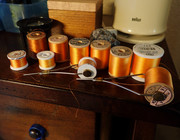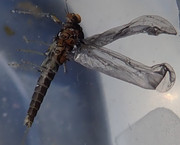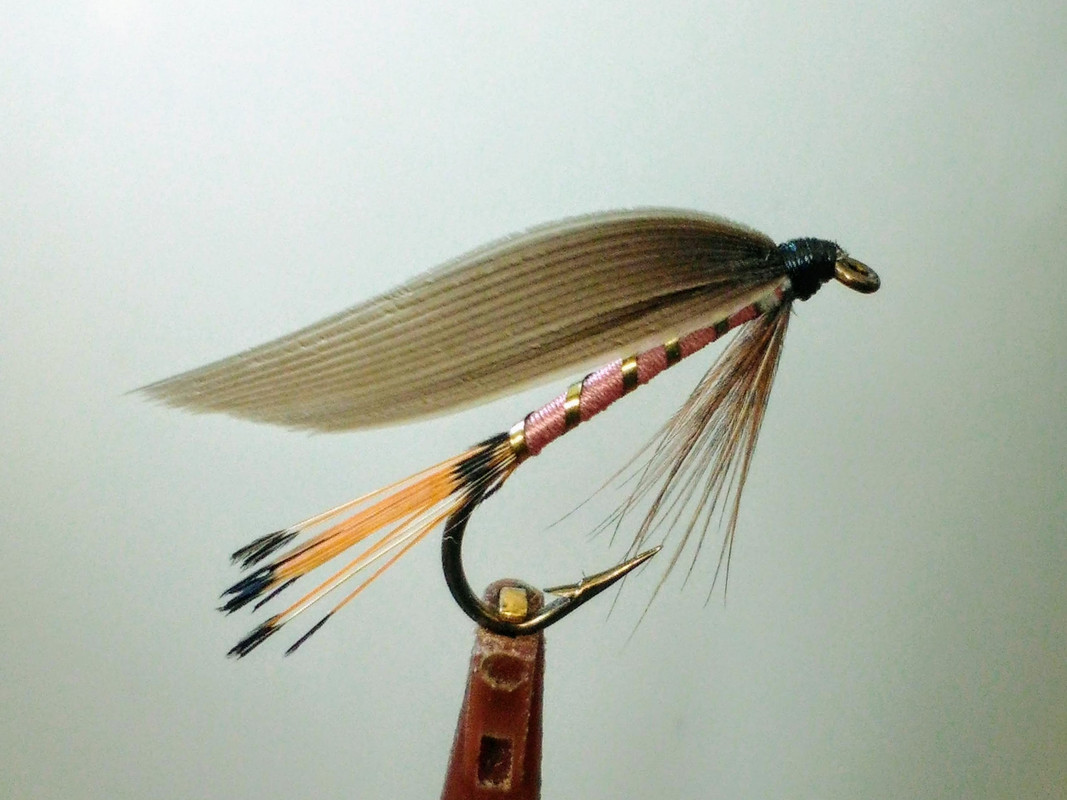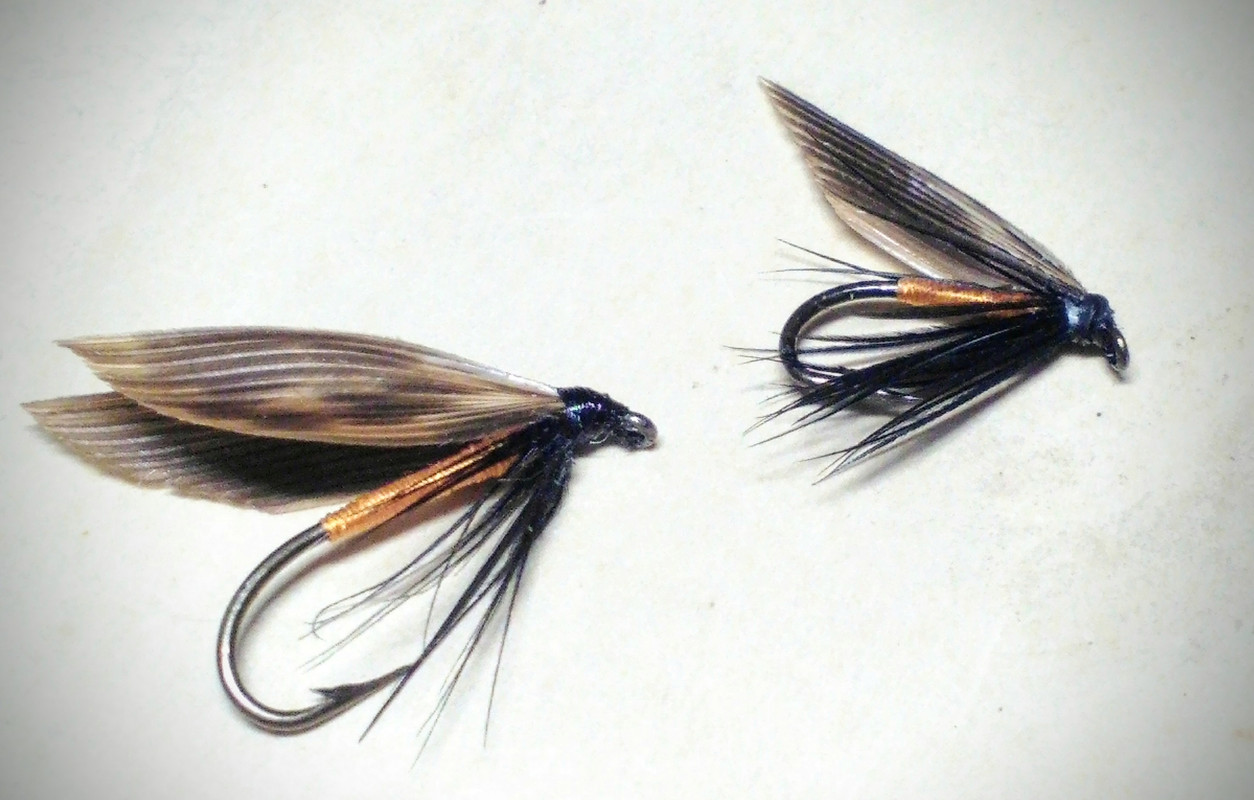Silk floss vs thread
Moderators: Ken M 44, joaniebo
Silk floss vs thread
#1Has anybody else found that silk thread works just as well and is easier to use than floss for soft hackles? It seems most books call for floss, but I have a huge range of thread colors already on hand for rod making. The flies I’ve tied work great and seem more durable than floss. They are certainly easier to tie with thread than with floss. What am I missing here? Why is floss the default?
John
John
Re: Silk floss vs thread
#2Tradition and tried and true? I agree with you as those errant strands will separate the floss at times giving us fits! Floss does have a sheen though and likely reacts when wet differently?
-
ted patlen
- Master Guide
- Posts: 408
- Joined: 01/25/11 19:00
Re: Silk floss vs thread
#3As Barebo stated silk is the age old material. Why it was originally used with thread is a good question and a good topic starter. My guess; it may have been used as a shiny sheath around the waxed thread that lashed the hut to the hook. As far as using thread instead, silk threads are twisted and untwisted according to the tyers whim so twisting silk floss into a thread must have been utilized as well. Again a another good topic to discuss.
Re: Silk floss vs thread
#4I have heard that same suggestion that silk floss is somehow more iridescent or can make a thinner body. I use Size A and 00 silk threads and the bodies can be as thin or as thick as I desire, even down to sz. 20 flies - just takes attention to how the material is applied and what diameter thread I use. I can untwist to get a thinner body, or twist to get something really segmented. See the first photo below comparing silk floss body (hook with no hackle) vs. thread body (2 hooks with bodies and hackle) in a glass filled with water (flies submerged). When I was looking at them I couldn't see any difference under fairly powerful magnification between the iridescence (i.e., sheen) of the floss, on the bare hook, and of the thread, on the flies. There is maybe a slight difference in the picture because the hook with the floss on it at the top of the picture was nearer the light source in the photo, but when I looked at them in natural and unnatural light, there is only the difference in color (the floss was a different slightly redder shade of orange than the thread which is more brown).
One thing I definitely see in the thread is a bit more segmentation, because of the tighter, cleaner more delineated wraps vs the wider floss with splayed fibers. I think this is really important, in my macro photos of aquatic insects, be it midges, stoneflies, mayflies, or caddis, segmentation shows through. In addition, as you can see with those soft hackles, the floss body is a great imitation of a trailing shuck, with the fatter body the caddis pulling out. Notice the air bubbles from the dubbing and CDC head that are naturally trapped. Those Yorkshire rivers where the soft hackle flies were developed in detail were caddis streams I think those dubbing body and dubbed or herl head flies did a great job of imitating pupa with the silk imitating a trailing shuck. Nemes wrote about these flies imitating caddis, but I've never seen mention of the silk imitating a shuck. In the photo below it's hard not to see that being a shuck, like the modern flies tied with zlon.
Bottom line - I think that silk thread is easier to use, it can be picked up second hand for super cheap at garage sales or on board classifieds or in craft stores, and it is more versatile than floss. One thing I have noticed is that when I do use floss, it's much easier to tie on a rotary vise. Tie it it, grab the end with hackle pliers, tie back to the end point, work the thread forward, then rotate the vise to wind. That way you never touch the thread. It's a pain in the butt though so much easier to wrap back and forth with thread on a bobbin, and besides, as shown in the second picture below, it's not like I don't already have enough thread to last several lifetimes or go into commercial production!
Interested in other perspectives in the mean time back to tying more grouse and oranges and BWO partridge and greens.
Cheers,
-John


One thing I definitely see in the thread is a bit more segmentation, because of the tighter, cleaner more delineated wraps vs the wider floss with splayed fibers. I think this is really important, in my macro photos of aquatic insects, be it midges, stoneflies, mayflies, or caddis, segmentation shows through. In addition, as you can see with those soft hackles, the floss body is a great imitation of a trailing shuck, with the fatter body the caddis pulling out. Notice the air bubbles from the dubbing and CDC head that are naturally trapped. Those Yorkshire rivers where the soft hackle flies were developed in detail were caddis streams I think those dubbing body and dubbed or herl head flies did a great job of imitating pupa with the silk imitating a trailing shuck. Nemes wrote about these flies imitating caddis, but I've never seen mention of the silk imitating a shuck. In the photo below it's hard not to see that being a shuck, like the modern flies tied with zlon.
Bottom line - I think that silk thread is easier to use, it can be picked up second hand for super cheap at garage sales or on board classifieds or in craft stores, and it is more versatile than floss. One thing I have noticed is that when I do use floss, it's much easier to tie on a rotary vise. Tie it it, grab the end with hackle pliers, tie back to the end point, work the thread forward, then rotate the vise to wind. That way you never touch the thread. It's a pain in the butt though so much easier to wrap back and forth with thread on a bobbin, and besides, as shown in the second picture below, it's not like I don't already have enough thread to last several lifetimes or go into commercial production!
Interested in other perspectives in the mean time back to tying more grouse and oranges and BWO partridge and greens.
Cheers,
-John


Last edited by BigTJ on 11/30/21 14:01, edited 1 time in total.
Re: Silk floss vs thread
#5A couple more photos, this time of the naturals (some baetis - adults and nymphs) highlighting the importance of segmentation in silk flies (or any fly for that matter). My BWO soft hackles use pale green wire to capture the segmentation, wound behind twisted, widely spaced silk wraps. White thread works well to but tends to be less durable so I don't use it.
Photo resolution dumbed down for ease of posting....
-John


Photo resolution dumbed down for ease of posting....
-John


Re: Silk floss vs thread
#6I am a proponent of Silk thread over floss all day long. The fly below is a Pink Lady of George LaBranche fame tied wet. The body is Pearsalls Gossamer Salmonberry. I think the segmented effect of the silkthread adds significantly
To the flys overall appeal!
Tom
url=https://postimg.cc/Lq7x00XZ] [/url]
[/url]
To the flys overall appeal!
Tom
url=https://postimg.cc/Lq7x00XZ]
 [/url]
[/url]Re: Silk floss vs thread
#7The Pink Lady is certainly beautiful and so classy - she's well dressed!
- roycestearns
- Bamboo Fanatic
- Posts: 1827
- Joined: 06/10/08 18:00
Re: Silk floss vs thread
#9I'd love to hear more from Teddy on this.
Pure speculation on my part:
- Tradition is the first thing that comes to mind.
- If you've ever tied in hand, you would know your tying thread would be heavily waxed (tying wax not dubbing wax) and it would be impossible to maintain the color
- floss would only take a couple of turns to cover a small hook vs many turns of a gossamer or naples size thread, so from a production standpoint efficiency would favor floss.
You were specific about soft hackles, but outside of small trout flies, thread becomes impossible to lay down as smooth as floss. If you needed to build up a body, floss wins over thread every time. Think thick bodied early American Bass, lake or Salmon flies.
my 2 coppers.
Pure speculation on my part:
- Tradition is the first thing that comes to mind.
- If you've ever tied in hand, you would know your tying thread would be heavily waxed (tying wax not dubbing wax) and it would be impossible to maintain the color
- floss would only take a couple of turns to cover a small hook vs many turns of a gossamer or naples size thread, so from a production standpoint efficiency would favor floss.
You were specific about soft hackles, but outside of small trout flies, thread becomes impossible to lay down as smooth as floss. If you needed to build up a body, floss wins over thread every time. Think thick bodied early American Bass, lake or Salmon flies.
my 2 coppers.
Re: Silk floss vs thread
#10Agreed. The only application I can see floss making more sense is in bigger flies but that’s just tying efficiency not for a performance advantage. In other words I don’t see making 3/0 classics with thread bodies.
Re: Silk floss vs thread
#11John,
What traditional sources are you getting the floss recipe from? I’ve always understood the traditional method to include waxing the silk and that tends to make a mess of floss by tearing strands. Using wax would also tend to negate the submerged distinction between silk thread and floss. I thought most folks used Pearsalls Gossamer silk thread for traditional soft hackles, that’s how I tie them, but now you have me wondering.. Syd Glasso did call for floss on his spey patterns and that supports your point about larger flies. Good thread (:
Dwight
What traditional sources are you getting the floss recipe from? I’ve always understood the traditional method to include waxing the silk and that tends to make a mess of floss by tearing strands. Using wax would also tend to negate the submerged distinction between silk thread and floss. I thought most folks used Pearsalls Gossamer silk thread for traditional soft hackles, that’s how I tie them, but now you have me wondering.. Syd Glasso did call for floss on his spey patterns and that supports your point about larger flies. Good thread (:
Dwight
Re: Silk floss vs thread
#12Skues used floss for the abdomen on some of his nymphs. Nemes also called for bare floss abdomens on many wets. The trout I've spoken to are pretty secretive, though... Can't seem to get a word out of them!
Re: Silk floss vs thread
#13Related thought: the iridescence John mentioned (which is something most of us seem to favor) is only present when air is trapped in the fibers. Once fully saturated with water, I believe materials lose their iridescent quality. I think this is also true of peacock herl once it’s fully soaked, which takes a while. Maybe waxing the thread preserves some of silks iridescence while also enhancing durability? Doesn’t shellac preserves silk iridescence on our rods because the alcohol evaporates leaving interstitial air pockets in the thread?
-
WiFlyFisher
- Bamboo Fanatic
- Posts: 1557
- Joined: 03/19/12 10:29
Re: Silk floss vs thread
#14From The North Country Fly Yorkshire's Soft Hackle Tradition by Robert Smith, page #192...
"The un-waxed silk for the body of the fly, and the properties the silk exhibits, allow the fly-dresser to achieve superb impression of translucency. (It is important to state that the process of waxing the silk in relation to dressing North country patterns was merely to enable the fly-dresser to bind down the horsehair. or gut cast, to the hook, and not to aid the translucency of the silk body). The impression is enhanced when coupled with the careful addition of a very sparse mist of dubbing which glistens and sparkles like the transmitted light that passes through the bodies of natural insects."
Never in Rob's book does he mention using silk floss that I have read.
In Wet Fly Tying and Fishing by Roger Fogg on page #108 he states "The bodies of soft-hackled spiders may be constructed of floss silk wound over the same shade of tying silk and Pearsall's Marabou floss silk is available in the same shades as the tying silk. The theory behind using floss silk is that, when wet, it provides the impression of translucence, but is easily damaged by a trout's teeth,, ". Roger ends by stating he doesn't recommend floss.
John
"The un-waxed silk for the body of the fly, and the properties the silk exhibits, allow the fly-dresser to achieve superb impression of translucency. (It is important to state that the process of waxing the silk in relation to dressing North country patterns was merely to enable the fly-dresser to bind down the horsehair. or gut cast, to the hook, and not to aid the translucency of the silk body). The impression is enhanced when coupled with the careful addition of a very sparse mist of dubbing which glistens and sparkles like the transmitted light that passes through the bodies of natural insects."
Never in Rob's book does he mention using silk floss that I have read.
In Wet Fly Tying and Fishing by Roger Fogg on page #108 he states "The bodies of soft-hackled spiders may be constructed of floss silk wound over the same shade of tying silk and Pearsall's Marabou floss silk is available in the same shades as the tying silk. The theory behind using floss silk is that, when wet, it provides the impression of translucence, but is easily damaged by a trout's teeth,, ". Roger ends by stating he doesn't recommend floss.
John
Re: Silk floss vs thread
#15Look at the photos of my flies above and zoom in. The silk thread has no air in it - the few bubbles you see are on the outside surface not in the silk itself. Nor does the floss have any bubbles. They both are translucent you can see the hook through the silk on the two flies on the right with enough light passing through them. Air not required. Shellac not needed.Dwight wrote: ↑12/03/21 15:25Related thought: the iridescence John mentioned (which is something most of us seem to favor) is only present when air is trapped in the fibers. Once fully saturated with water, I believe materials lose their iridescent quality. I think this is also true of peacock herl once it’s fully soaked, which takes a while. Maybe waxing the thread preserves some of silks iridescence while also enhancing durability? Doesn’t shellac preserves silk iridescence on our rods because the alcohol evaporates leaving interstitial air pockets in the thread?
To those wanting to kick silk up a notch wrap it over flashabou and then hit it with thin UV resin. The results are obviously non traditional but it gives an amazing shimmer attractive to trout especially in more off-color water. In the gin clear conditions just the silk is fine.
Re: Silk floss vs thread
#16Dwight - Nemes, his quotations of previous writers, and other books from the 70’s to 90’s referring to old patterns. I don’t have the original texts to fall back on.Dwight wrote: ↑12/03/21 14:35John,
What traditional sources are you getting the floss recipe from? I’ve always understood the traditional method to include waxing the silk and that tends to make a mess of floss by tearing strands. Using wax would also tend to negate the submerged distinction between silk thread and floss. I thought most folks used Pearsalls Gossamer silk thread for traditional soft hackles, that’s how I tie them, but now you have me wondering.. Syd Glasso did call for floss on his spey patterns and that supports your point about larger flies. Good thread (:
Dwight
Cheers,
John
-
WiFlyFisher
- Bamboo Fanatic
- Posts: 1557
- Joined: 03/19/12 10:29
Re: Silk floss vs thread
#17Personally, I to prefer silk thread over any type of floss.
John, when I think of "silk floss fly bodies" I think of the of the older American "winged" wet fly patterns and classic dry fly patterns. If you look in McClane's Standard Fishing Encyclopedia he has beautiful colored plates of classic winged wet fly & dry fly patterns tied by Elsie Darbie calling for silk floss.
in the end the only thing that really matters is what the trout think.
Happy tying.
John
John, when I think of "silk floss fly bodies" I think of the of the older American "winged" wet fly patterns and classic dry fly patterns. If you look in McClane's Standard Fishing Encyclopedia he has beautiful colored plates of classic winged wet fly & dry fly patterns tied by Elsie Darbie calling for silk floss.
in the end the only thing that really matters is what the trout think.
Happy tying.
John
Re: Silk floss vs thread
#18John, I suppose I was referring to your references in #4 to iridescence rather than translucence. Iridescence being a degree of reflection and translucence being a degree of transparency. Your beautiful pics of mayfly nymphs certainly exude translucency as do your submerged soft hackles. This thread has me wanting to go back and read Pritt.
Re: Silk floss vs thread
#19This fly is the Cooper from Trout by Bergman. The body is Pearsalls orange #19. The gossamer thread surely shows translucency,sparkle and sheen. I have been using Pearsalls for a number of years now because of these qualities. And by the way to tie the flies I have waxed the thread with 722 fly tiers wax and these qualities still stand out.Pearsalls Gossamer has been the standard for fly tying since the 1890's. If I do tie larger flies I would use Pearsalls Maribou or perhaps even stout. Modern 14/0 threads however are my standard for flies 20 and down.
Tom
url=https://postimg.cc/z3VzNNwP] [/url]
[/url]
Tom
url=https://postimg.cc/z3VzNNwP]
 [/url]
[/url]- roycestearns
- Bamboo Fanatic
- Posts: 1827
- Joined: 06/10/08 18:00
Re: Silk floss vs thread
#20Careful.Pearsalls Gossamer has been the standard for fly tying since the 1890's.
Maybe in Europe ... the NE American silk manufacturing in the 1840's created a market for American silk thread for rod manufacturing and fly tying. An American rod maker in SE Vermont was significantly involved in the efficient importation of raw silk for the thread manufacturers by creating a spool that efficiently captured silk from worm to spool.
An interesting thing happened in the 1830's the value of the food for silkworms, mulberry trees, started to become a bigger market then the silk, a bit like the Danish tulip market.
https://americanhistory.si.edu/blog/silk
https://digitalcommons.library.umaine.e ... oryjournal
Belding Corticelli, Hemmingway, Rice, Clarks, etc ...
